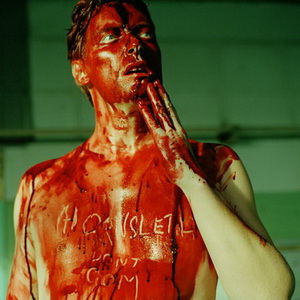

Kristian von
HORNSLETH
1988-94 Graduate MA.
The Royal Danish Academy of Fine Art.
Department of Architecture. Copenhagen.
1983-86 Geology studies. University of Copenhagen
1987-88 Copenhagen Business School
http://www.hornsleth.com
Kristian von Hornsleth, born 1963, lives and works
in Copenhagen. He is known for creating art
about branding and identity and his paintings with
'his name writing across the middle is in over
1000 homes in Denmark and around the world.
His Africa-project, in which an African village
changed all their names to Hornsleth and in
exchange received an a pig or a goat, made
headlines all over the world and the village
has even been visited by Prince Charles of
England.
Hornsleths weapon stock market
work called The Hornsleth Arms Investment
Project, focuses on human relations to cruelty and evil,
that exist in every part of the accepted capitalism.
Furthermore Hornsleth is known for his many
brandings of consumer items on everything
from Lamborghinis to porno films and in every
sense the question of whether publicity is
more important than the product itself.
There is no product, there is only marketing, Kristian von Hornsleth
Kristian von Hornsleth
(Text by Wolf GŁnter
Thiel)
Kristian Hornsleth is a concept-artist in the field of
painting and artistic interventionism. He cultivates both pathes in his
work. He lives and works in Kopenhagen. Throughout his whole work he
expresses critic about art institutions, art audiences and established
art related structures. One of his main artistic claims was "Fuck You
Artlovers" in which he attacked the cultural audience. He used images
which were taboo in many ways. He implemented hardcore ponography, anti
religious as well as political completely incorrect items like attacking
religious motives or homosexuality and feminism. He also barnded his
artworks with putting his name Hornsleth like a logo on the canvass on
top of the image. His work was banned from the contemporary art scene
and institutional show-business. Therefore he has built his fame on
street credibility. He reached the street, in coallition with danish
Rappers, the Hells Angels and "Streetware-Fashion". Today he is
regularly on Television programmes commenting on art and mainstream
cultural phenomenons. He is a national hero and known like a pop-star.
To understand his actual work it is interesting to look into three different aspects which we like to call interventionism, splinter of distrust and psycho pop. Interventionism is often recognized as conceptual art and is commonly a form of performance art. It is associated with the Viennese Actionists, the Dada movement and Neo-Dadaists. Although intervention by its very nature carries an implication of subversion, it is generally accepted as a legitimate form of art and is often carried out with the endorsement of those in positions of authority over the artwork, audience or venue/space to be intervened in. Alone Hornsleth attacks the artsystem in terms of their institutional established structures. The result was that the leaders of the systems critics, curators, gallerists or collectors banned him out of their hemisphere.
However, unendorsed like the Hornsleth Uganda project are leading to debates between artist, intellectual testimonials and the authorities of justice, politics and established economic structures. This way the art provokes a discussion which shows socio-cultural deficits in politics, economy or society and which are hidden and generally avoided by the responsible authorities or participants. The Uganda project was a project to show western economical and political repression with the subtitle "We want to help you, but we want to own you" Hornsleth describes the project: " 100 people from a small village in Uganda made a free deal with him. The deal was that the villagers all change their name to "Hornsleth" in exchange for household animals. Each person went through the official legal name change process. A national Uganda ID card was issued to each person to show their new "Hornsleth" name." The project became so controverse, that the government of Uganda wrote a protest note to the Danish government to close the exhibition, before it even started. The Ambassy of Uganda in Danmark pressured some dancers from Uganda living in Danmark not to perform during the opening. The danish minister for foreign affairs gave an danish state television were he had to explain why the show had every right ro open. He explained to the danish television audience the term of freedom of speech, the freedom of art and that artistic as well as personal oppinion has every right to be expressed. This connected to an artwork is shurely a sensational effect of art on politics. The international media, especially the print media and the homepages of CNN, NBC, BBC, Herald Tribune, London Times as well as all big danish newspapers covered the project. The artpress kept at the same moment more or less silent. The project is one of its kind in art history and one of the most controversial artpieces which was discussed on this media level.
The life in contemporary societies is following a general idea of positivism. Everything is solved by the free markets, as we are told by the neo-liberal strategists. At the same time while global economy is prospering, the empowered people in the underdeveloped countries loose more and more of their democratic options as they are guranteed by the carta of human rights. Even in the european societies we gain a growing number of people who are loosing touch with the prosperious economies of society. This development is covered by a matrix of positivism as it is projected through media and political statements of politicians in charge. Kristian von Hornsleth opposes this strategy of positivism and introduces the splinter of distrust and evil as a strategy and communication tool. As we see it in the "Uganda Village Project" this is a possible way to start a new discussion and change the general oppinion in and through the media. The aspect of distrust and evil opens the eyes of people and let them start to discuss the topic.
The German Philosopher Theodor Adorno saw the culture and media industry as an arena in which critical tendencies or potentialities were eliminated. He argued that these industries, which produce and circulate cultural commodities through the mass media, manipulated the population. Popular culture is identified as a reason why people become passive; the easy pleasures available through consumption of popular culture made people docile and content.
Von Hornsleth subverts these industries with the splinter of distrust and the evil factor and shows the ugly face behind the happy face of positivism. What Adorno described for the culture industry in general is visible in all parts of societies in Europe today. Marketing and Public Relations through Media have substituted content and critical thinking, especially in the artworld. Talking about art means talking about the global art system and not about the ideas or critical potential which is represented. This leads to "pseudo-individualization and the always-the-same."(Adorno). Hornsleth attacks these borgouise consumers of bohemian life style from the beginning on "Fuck you art lovers" has been his answer ever since. Culture industries cultivate false needs; that is, needs created and satisfied by easy opportunism. True needs, in contrast, are freedom, creativity, and genuine happiness which are not expressed in the contemporary art. To wake these people up he promoted the aggressive answer and attacked them as well as the markets, by his own way of marketing and public relation. The attack of the general positivism which is common in the global world of art and culture is an evident proof of what Adorno prophecised. Adorno's "negative dialectics" was an attempt to articulate a non-dominating thought that would recognize its limitations and accept the non-identity and reality of that which could not be subsumed under the subject's concepts.
Jean Baudrillard speaks in "Le systŤme des objects" of the true splinter of the real cross which everyone likes to call his own at his home. The real splinter of distrust or evil cuts an edge into the matrix of positivism. The evil, scary slot of uneasyness which exactly produces the awareness to discover the artworks of the kind Adorno suggests. Herbert Marcuse's 1965 essay "Repressive Tolerance", in which he claimed capitalist democracies can have totalitarian aspects argues that genuine tolerance does not tolerate support for repression, since doing so ensures that marginalized voices will remain unheard. He characterizes tolerance of repressive speech as "inauthentic." Von Hornsleths answer is authentic and artistic, in showing exactly what has been hided in the arts: aspect of hardcore pornography, brutality and total poverty. Instead, von Hornsleth promotes a discriminatory form of tolerance that does not allow so-called "repressive" intolerance to be hided. He opens it to the public.
Von Hornsleth attacks the matrix of positivistic and
sentimental entertainment as we see it samewise in the cultural and in
the media world. The matrix constituted through simulation is attacked
and deconstructed by his new work. In the movie "The Matrix" Morpheus
says an important sentence and that is due to Hornsleth "?I tell you why
you are here. You are here, because you know something. Something which
you cannot explain. But you feel it. You have felt it your whole live,
that there is something wrong with this world. You know it, but its
there. It is like a splinter in your head , which makes you crazy ?"
This sentence said by Morpheus seems to describe the paintings and the
idea behind the paintings of Hornsleths recent paintings the best. This
strong attack on the the media is by the same means a strong statement
against the meaningless of art and missing critical potential in the
common grounds of the global artworld and related culture industry.
![]()



